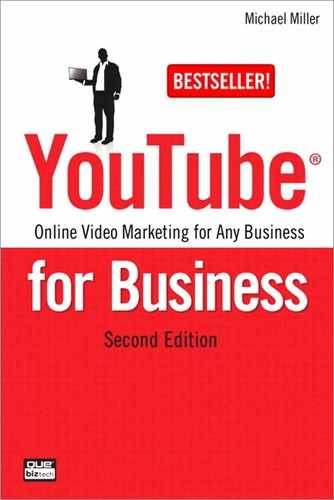15. Managing Comments
One of the fun things about marketing via YouTube is that you get to immediately see the comments and responses from people who view your videos. Although this can be fun, it isn’t always pleasant, which is why YouTube lets you manage these comments.
Enabling Comments—and Other User Response Features
Viewers can leave both text comments and video responses to your videos—if you let them. At your discretion, you can allow, disallow, or allow with prior approval either comments or video responses for any individual video you upload. (This means you can allow comments for one video and disallow comments for another.)
To control comments and video responses, click the down arrow next to your name at the top of any YouTube page, then select My Videos; this displays a list of all your videos. Then click the Edit button for the video you want to control. When the edit page for this video appears, scroll down to the Broadcasting and Sharing Options section, shown in Figure 15.1. We’ll skip the Privacy section, which we’ve previously discussed, and focus on the remaining half-dozen options.
Figure 15.1 Enabling or disabling comments and video responses.
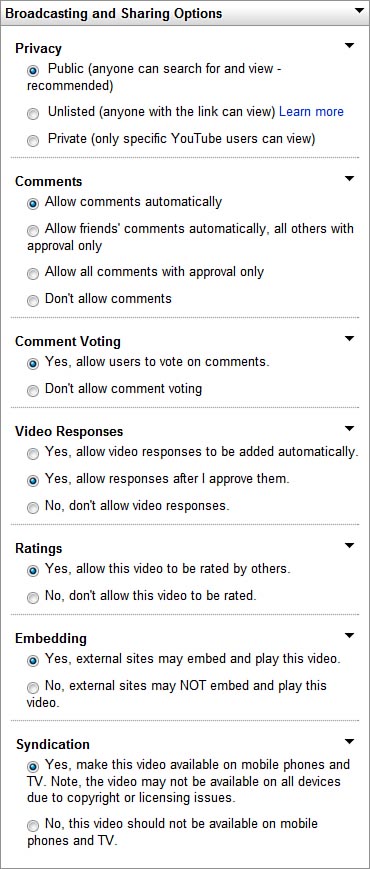
Note
![]()
You might need to expand some of the items in this section to edit them. Click the right arrow to expand a section; click the down arrow to contract an expanded section.
Comments
By default, anyone viewing your video can leave text comments about the video, like those shown in Figure 15.2. You can disable comments, however, or choose to moderate comments before they appear publicly. The options you have for accepting comments include the following:
• Allow Comments Automatically—Viewers can submit text comments, which appear immediately on your video page.
• Allow Friend Comments Automatically, All Others with Approval Only—Viewers can submit text comments, but you have to approve each comment before it appears on your video page—unless the viewer is part of your preapproved Friends list.
• Allow All Comments with Approval Only—All comments, even those from friends, have to be preapproved.
• Don’t Allow Comments—The Comments section does not appear on the page for this video.
Figure 15.2 Viewer comments beneath a YouTube video.
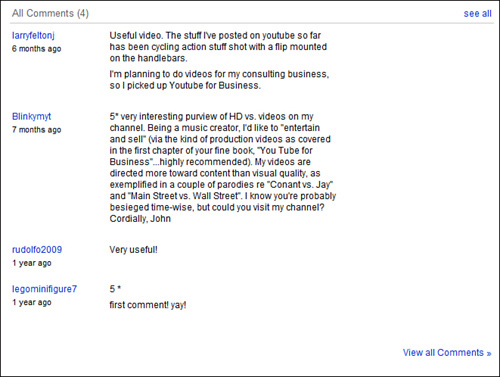
Should you allow comments on your videos? I think so; even negative comments provide valuable feedback from consumers. However, not all companies are culturally suited to deal with potentially negative comments, or simply don’t have the resources to monitor and respond to comments. We’ll discuss this more in the “Dealing with Negative Comments” section, later in this chapter.
Comment Voting
This feature lets viewers give up or down votes on comments left by other viewers. Select Yes to allow comment voting or No to disallow it.
Video Responses
When you enable this option, viewers can make and upload their own videos in response to your video. You can choose from the following options:
• Yes, Allow Video Responses to Be Added Automatically—Viewers can upload their video responses, which appear immediately on your video page.
• Yes, Allow Video Responses After I Approve Them—Any video responses have to be approved by you before they appear on your video page.
• No, Don’t Allow Video Responses—The video response option does not appear on your video page.
Ratings
In lieu of (or in addition to) detailed text comments, you can also allow your video to be rated by viewers. Viewers rate videos by giving either a thumbs up (positive) or thumbs down (negative) vote.
Tip
![]()
To view the overall rating for your video, go to that video’s page and scroll to the options box below the video player; the rating displays there.
Of course, you have the option of not allowing viewers to rate your video. This might be desirable if you don’t want your business’s videos perceived in a negative fashion. On the other hand, if you have a popular video, you probably want to enable ratings—highly rated videos rank higher in YouTube search results than do poorly rated ones.
Your option in regard to ratings is simple: Check Yes to allow ratings or No to disallow them.
Embedding
YouTube makes it easy for any user to embed your video in his or her own website or blog. If you want wider exposure for your video, check Yes to display the embeddable HTML code. If, on the other hand, your lawyers tell you that you need to keep complete control over where and how users view your video, click No to hide the embeddable code.
Tip
![]()
I can think of no good reason not to allow embedding, unless you have a legal staff paranoid about copyright and fair usage. If you want to create a truly viral video, you have to allow fans to embed the video across the Web.
Syndication
You can achieve even wider viewership by making your video accessible to viewers on mobile phones and TV. YouTube dubs this added exposure syndication, and you can turn it on or off for any specific video.
Approving Comments and Video Responses
If you choose the “with approval” option for comments or video responses, you have to manually approve any comments or responses viewers post to this video. When a viewer posts a comment or response, YouTube sends you an email like the one in Figure 15.3.
Figure 15.3 YouTube sends an email notification when you receive a comment or response to your video.
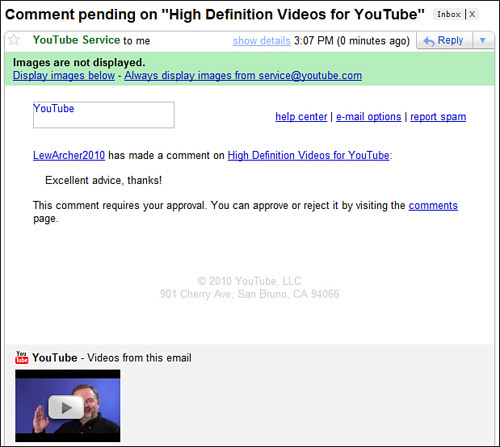
Thus notified, go to the YouTube site click the down arrow next to your name at the top of any page, and select Inbox. When the Messages page opens, click the Comments link along the left side. As you can see in Figure 15.4, this displays a list of all pending comments/responses in your inbox.
Figure 15.4 Pending comments and responses in your YouTube inbox.
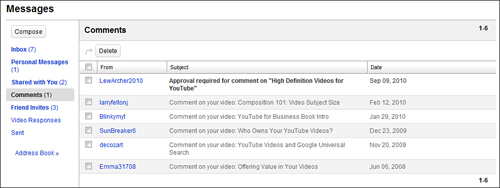
Click the message link to display the comment, as shown in Figure 15.5.
Figure 15.5 Responding to a viewer comment.

To approve a comment or response to your video, and display that comment publicly on your video page, click the Approve button. To not approve (and not display) a comment, click the Ignore link.
Dealing with Negative Comments
When you let viewers comment on your videos, you’re opening a Pandora’s Box. Yes, you’ll receive some useful comments from satisfied viewers, but you’ll also receive some negative comments—some of which might be downright nasty.
Some companies want to see only positive comments, which is fine but not necessarily realistic; you’ll never have 100% approval of anything you do. Other companies are more open minded and don’t mind the negative comments; they feel it presents a forthright, warts-and-all image to the market.
There’s no right or wrong here. Just know that if you enable comments, you will receive some negative ones. How you respond to those negative comments depends on your how your company deals with criticism.
Removing Viewer Comments and Responses
One way to deal with negative comments is simply to remove them. All you have to do is go to the edit page for that video and highlight the comment you want to remove. This displays a number of new buttons, as shown in Figure 15.6; the one you’re interested in is the Remove (trashcan) button. Just click the Remove button and the comment disappears. Voila!
Figure 15.6 Removing an unwanted comment—click the Remove button.
![]()
Blocking Specific Viewers from Leaving Comments
Every now and then, you’ll run into a virtual stalker, a disgruntled customer (or perhaps a competitor) who delights in leaving negative comments on all your videos. Although you can manually remove all of this user’s comments, a better approach is to keep him from leaving those comments in the first place.
To this end, YouTube enables you to block individual members from leaving comments and responses (and from flooding your YouTube inbox with negative messages). To block a user, all you have to do is click that member’s name to access his channel page, scroll to the information box above the user’s Profile, and click the Block User link. This blocks the user from commenting on your videos and contacting you.
Tip
![]()
You can also block a user directly from the video page. Just click the Block User button by that user’s comments.
Responding to Negative Comments
Another way to deal with negative comments is to deal with them head on—by responding directly to the comments. YouTube lets you add your own responses to any comments left about your videos; this can be a good forum for exchanging views and opinions with your customer base.
If you decide to respond to a negative comment, a few things to keep in mind. First, speed is of the essence. There’s no point responding to comments made a month or two ago; you need to jump in while the conversation is fresh. This shows that you take viewer comments seriously enough to respond quickly.
You also need to respond positively, even to the most negative comments. Don’t be defensive, and certainly don’t be offensive; don’t resort to name-calling or other insults. You need to be the adult in what might otherwise be a childish situation. Be professional, be calm, be cool, be collected. Don’t let yourself get angry.
But don’t be so calm cool and collected that you come off as being a PR flack. Yes, you probably should toe the company line, but you also have to genuinely respond to comments, on a personal basis. Admit to mistakes, if there are any. Offer help or advice, if any is to be given. Be sympathetic. Apologize. (You’d be surprised how far a genuine “I’m sorry for your problems” will go.)
There’s a certain amount of acceptance involved in all this. You simply can’t control what people say about you, no matter how much you (or upper management) might like to. You’re always going to have some people saying bad things about your company, your products, and even your people. You can’t take it personally. You have to accept that negative comments exist, and learn to live with it. A thick skin is a must, but it also helps to develop an understanding of how people use the Internet to amplify their petty (and more-than-petty) complaints. Remember, as a company, you are a lot bigger than any single complaint or complainer.
Caution
![]()
In some cases, your best recourse might be not to respond to a negative comment. When you enter your reply, you run the risk of fanning the fires of a burgeoning flame war, from which neither the disgruntled viewer nor you might come off looking good. Sometimes the better course of valor is to just walk away—and respond with silence only.
Fortunately, it’s easy enough to respond to comments on YouTube. Just go to the video page and scroll down to the comments section under the video window; you should see a list of all viewer comments. Highlight the comment to which you want to reply, and then click the Reply button. This displays a reply box, as shown in Figure 15.7. Enter your reply into this box, and then click the Post button. Your reply displays directly beneath the comment in question.
Figure 15.7 Replying to a viewer’s comments.

The Big Picture
You need to determine, early on, how you want to respond to the inevitable negative comments posted about your videos. You can choose to ignore the negative comments, reply to them, or just delete them. You can also choose to skip the issue entirely by not enabling the comments feature for your videos. If your company is particularly thin-skinned or you think your videos might generate particularly controversial responses, this might be the way to go. Otherwise, consider all comments—positive or negative—as valuable feedback, and learn how to engage even negative viewers in a positive fashion.
